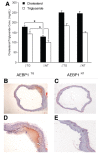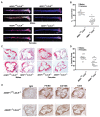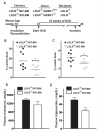Adipocyte enhancer-binding protein 1 (AEBP1) (a novel macrophage proinflammatory mediator) overexpression promotes and ablation attenuates atherosclerosis in ApoE (-/-) and LDLR (-/-) mice
- PMID: 21687917
- PMCID: PMC3188858
- DOI: 10.2119/molmed.2011.00141
Adipocyte enhancer-binding protein 1 (AEBP1) (a novel macrophage proinflammatory mediator) overexpression promotes and ablation attenuates atherosclerosis in ApoE (-/-) and LDLR (-/-) mice
Abstract
Atherogenesis is a long-term process that involves inflammatory response coupled with metabolic dysfunction. Foam cell formation and macrophage inflammatory response are two key events in atherogenesis. Adipocyte enhancer-binding protein 1 (AEBP1) has been shown to impede macrophage cholesterol efflux, promoting foam cell formation, via peroxisome proliferator-activated receptor (PPAR)-γ1 and liver X receptor α (LXRα) downregulation. Moreover, AEBP1 has been shown to promote macrophage inflammatory responsiveness by inducing nuclear factor (NF)-κB activity via IκBα downregulation. Lipopolysaccharide (LPS)-induced suppression of pivotal macrophage cholesterol efflux mediators, leading to foam cell formation, has been shown to be mediated by AEBP1. Herein, we showed that AEBP1-transgenic mice (AEBP1(TG)) with macrophage-specific AEBP1 overexpression exhibit hyperlipidemia and develop atherosclerotic lesions in their proximal aortas. Consistently, ablation of AEBP1 results in significant attenuation of atherosclerosis (males: 3.2-fold, P = 0.001 [en face]), 2.7-fold, P = 0.0004 [aortic roots]; females: 2.1-fold, P = 0.0026 [en face], 1.7-fold, P = 0.0126 [aortic roots]) in the AEBP1(-/-)/low-density lipoprotein receptor (LDLR )(-/-) double-knockout (KO) mice. Bone marrow (BM) transplantation experiments further revealed that LDLR (-/-) mice reconstituted with AEBP1(-/-)/LDLR (-/-) BM cells (LDLR (-/-)/KO-BM chimera) display significant reduction of atherosclerosis lesions (en face: 2.0-fold, P = 0.0268; aortic roots: 1.7-fold, P = 0.05) compared with control mice reconstituted with AEBP1(+/+)/LDLR (-/-) BM cells (LDLR (-/-)/WT-BM chimera). Furthermore, transplantation of AEBP1(TG) BM cells with the normal apolipoprotein E (ApoE) gene into ApoE (-/-) mice (ApoE (-/-)/TG-BM chimera) leads to significant development of atherosclerosis (males: 2.5-fold, P = 0.0001 [en face], 4.7-fold, P = 0.0001 [aortic roots]; females: 1.8-fold, P = 0.0001 [en face], 3.0-fold, P = 0.0001 [aortic roots]) despite the restoration of ApoE expression. Macrophages from ApoE (-/-)/TG-BM chimeric mice express reduced levels of PPARγ1, LXRα, ATP-binding cassette A1 (ABCA1) and ATP-binding cassette G1 (ABCG1) and increased levels of the inflammatory mediators interleukin (IL)-6 and tumor necrosis factor (TNF)-α compared with macrophages of control chimeric mice (ApoE (-/-)/NT-BM ) that received AEBP1 nontransgenic (AEBP1(NT) ) BM cells. Our in vivo experimental data strongly suggest that macrophage AEBP1 plays critical regulatory roles in atherogenesis, and it may serve as a potential therapeutic target for the prevention or treatment of atherosclerosis.
Figures






Similar articles
-
Adipocyte enhancer-binding protein 1 is a potential novel atherogenic factor involved in macrophage cholesterol homeostasis and inflammation.Proc Natl Acad Sci U S A. 2006 Feb 14;103(7):2346-51. doi: 10.1073/pnas.0508139103. Epub 2006 Feb 6. Proc Natl Acad Sci U S A. 2006. PMID: 16461908 Free PMC article.
-
LPS-induced suppression of macrophage cholesterol efflux is mediated by adipocyte enhancer-binding protein 1.Int J Biochem Cell Biol. 2009 Jul;41(7):1518-25. doi: 10.1016/j.biocel.2009.01.003. Epub 2009 Jan 8. Int J Biochem Cell Biol. 2009. PMID: 19166963
-
Activation of liver X receptor decreases atherosclerosis in Ldlr⁻/⁻ mice in the absence of ATP-binding cassette transporters A1 and G1 in myeloid cells.Arterioscler Thromb Vasc Biol. 2014 Feb;34(2):279-84. doi: 10.1161/ATVBAHA.113.302781. Epub 2013 Dec 5. Arterioscler Thromb Vasc Biol. 2014. PMID: 24311381 Free PMC article.
-
PPARgamma1 and LXRalpha face a new regulator of macrophage cholesterol homeostasis and inflammatory responsiveness, AEBP1.Nucl Recept Signal. 2010 Apr 16;8:e004. doi: 10.1621/nrs.08004. Nucl Recept Signal. 2010. PMID: 20419060 Free PMC article. Review.
-
Regulation of IkappaBalpha function and NF-kappaB signaling: AEBP1 is a novel proinflammatory mediator in macrophages.Mediators Inflamm. 2010;2010:823821. doi: 10.1155/2010/823821. Epub 2010 Apr 12. Mediators Inflamm. 2010. PMID: 20396415 Free PMC article. Review.
Cited by
-
Lactation defect with impaired secretory activation in AEBP1-null mice.PLoS One. 2011;6(11):e27795. doi: 10.1371/journal.pone.0027795. Epub 2011 Nov 16. PLoS One. 2011. PMID: 22114697 Free PMC article.
-
Programming With Varying Dietary Fat Content Alters Cardiac Insulin Receptor, Glut4 and FoxO1 Immunoreactivity in Neonatal Rats, Whereas High Fat Programming Alters Cebpa Gene Expression in Neonatal Female Rats.Front Endocrinol (Lausanne). 2022 Jan 5;12:772095. doi: 10.3389/fendo.2021.772095. eCollection 2021. Front Endocrinol (Lausanne). 2022. PMID: 35069436 Free PMC article.
-
Extracellular vesicle-derived AEBP1 mRNA as a novel candidate biomarker for diabetic kidney disease.J Transl Med. 2021 Jul 31;19(1):326. doi: 10.1186/s12967-021-03000-3. J Transl Med. 2021. PMID: 34332599 Free PMC article.
-
Association of adipocyte enhancer-binding protein 1 with Alzheimer's disease pathology in human hippocampi.Brain Pathol. 2018 Jan;28(1):58-71. doi: 10.1111/bpa.12475. Epub 2017 Feb 8. Brain Pathol. 2018. PMID: 27997051 Free PMC article.
-
Inactive metallopeptidase homologs: the secret lives of pseudopeptidases.Front Mol Biosci. 2024 Jul 10;11:1436917. doi: 10.3389/fmolb.2024.1436917. eCollection 2024. Front Mol Biosci. 2024. PMID: 39050735 Free PMC article. Review.
References
-
- Ross R. Atherosclerosis: an inflammatory disease. N Engl J Med. 1999;340:115–26. - PubMed
-
- Libby P. Inflammation in atherosclerosis. Nature. 2002;420:868–74. - PubMed
-
- Tontonoz P, Nagy L, Alvarez JG, Thomazy VA, Evans RM. PPARgamma promotes monocyte/macrophage differentiation and uptake of oxidized LDL. Cell. 1998;93:241–52. - PubMed
-
- Nagy L, Tontonoz P, Alvarez JG, Chen H, Evans RM. Oxidized LDL regulates macrophage gene expression through ligand activation of PPARgamma. Cell. 1998;93:229–40. - PubMed
Publication types
MeSH terms
Substances
Grants and funding
LinkOut - more resources
Full Text Sources
Medical
Research Materials
Miscellaneous

